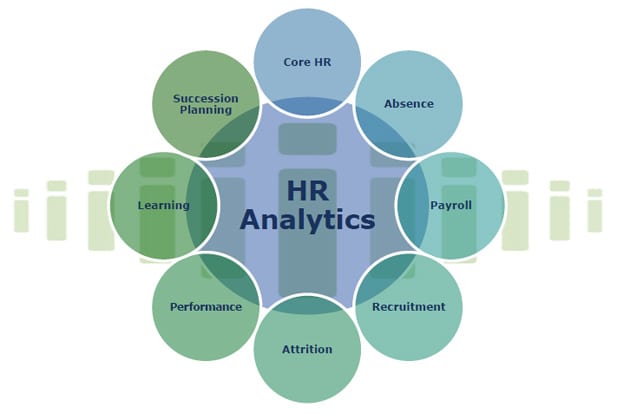
Data-driven HR Analytics has been very beneficial for human relations departments. Professional HR should apply this practice in order to recruit the right people in the right departments. Hiring employees is not easy because they should contribute their best talent to the company. This is why there is such a great need of using HR data analytics
HR analytics data analytics refers to analytics of people, workforce, or talent. The data enables an organization to estimate a range of HR metrics’ impact on the whole business performance. simply, HR analytics is Human Resources Management’s data-driven approach.
Heuvel & Bondarouk define the most applicable scientific HR analytics definition. Decades ago, human resource management might have applied a conventional approach to the process of recruitment, training, and maintaining employees. This HR analytics data-driven approach has been such a great development for human resources management worldwide.
What are The Main Function of Data-driven HR Analytics?
Data-driven HR is the procedure of getting data for informing decisions that relate to every human relation aspect. Those decisions relate to the recruitment process to hiring human resources to provide the salary, benefits, and compensations. The department of HR will analyze data about employees as it gets insights into the main motivation of human resources in joining the company.
The best thing about Data-driven HR is that the HR department can make workers or employees love their jobs and feel engaged. The analytics is also important to find out the reason why an employee decides to resign. It means data-driven HR is very beneficial in informing HR staff about the effort in improving the satisfaction and retention of employees.
How Beneficial HR Data Analytics Usage Is
Regardless of how easy it is to use data in HR analytics effectively, human resources staff should know several important things. The first and foremost thing is to get as complete data as possible about the current employees. The data may cover reviews of employees’ performance, demographic information, and so forth.
Once the data is complete, the human resource staff should organize it for the sake of easier analysis. It is as simple as creating databases or files like a spreadsheet containing the whole relevant information. After the completion of the analysis, HR staff can get detailed decisions about the strategy of human resources.
HR data analytics delivers great benefits for an organization. Analytics allows any kind of organization for measuring the people policies’ business impact. Predicting the workforce’s future is one of HR data analytics benefits as management can measure the practices of Human resource financial impact.
HR Analytics Facts
The HR department is required to mix HR data from various systems to start the HR analytics. One of the most common examples is the measurement of employee engagement’s impact on financial performance. The HR department should combine the annual engagement survey with performance data for measuring this relationship. The main areas of human relationships can change, depending on the information from HR analytics.
Data-driven HR analytics can calculate the budget for the development of learning with the business impact, or estimate new employees who will perform the best in the coming years. It is even amazing that predict employees who will resign within a year. It means that HR analytics can change the procedures of recruiting and selecting.
Data-driven HR helps human resource management in making better decisions in certain aspects, such as:
Supporting The Levels Of Engagement
Any organization needs to maintain strong employee engagement. Yet, it is easier said than done. By using HR data analytics, the HR department can figure out the company’s engagement levels from the gathered data from surveys, reviews of performance, and so forth. Improving engagement is beneficial to increase productivity among employees who were low in morale.
Improving the Quality of Recruitment
The human resource department’s main role is recruiting. It is not an easy role as it requires time, effort, and money. The use of data-driven HR Analytics can target the recruitment process by saving time and money. What’s more, the department has better chances of getting talented human resources.
Ability to Maintain Employees
After recruiting the most talented employees, then HR departments should maintain them by using the HR analytics data. It doesn’t only track the rates of employee development, but also identifies the most common problem areas. Putting together a strategy for retention which addresses common issues is much easier with HR analytics data.
Increasing Initiatives For Learning And Developing
Any company will have programs for employees to learn and develop. The data can help the HM department to understand the most effective training program. The department will customize the training that meets the employees’ needs by using People Analytics.
Starting HR analytics
The first and foremost thing to do is by finding out certain employees who might be very potential in making progress significantly. It is as easy as using standard statistics. This method can calculate organizational outcomes and people’s potential relationships. Besides, this kind of analytics will help a company to follow certain aspects like performance, absenteeism, burnout, and so forth.
The work of the human resource department will be much easier by using data-driven HR analytics. The available insights will lead to premeditated decisions while optimizing the step-by-step process of business. The work environment has a better atmosphere when the human relation department knows how to motivate the employees.
Keep in mind that data-driven HR analytics is very important for the human resource department. By optimizing its power, HR management can take the best decisions that relate to each aspect of employees’ strategy. The HR department of a company can use the data to make decisions properly as there are significant changes that took place in employment, as there is massive hybrid work popularity.
It requires comprehensive training for all HRD staff to apply the analytics, especially from a company with more than fifty employees. There are various professional courses available in HR data analytics. There are certificates for People Analytics Programs that will enhance the value of the HR department.
Click the image below to download for free.


